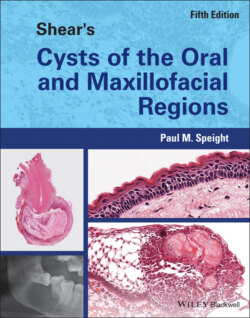Читать книгу Shear's Cysts of the Oral and Maxillofacial Regions - Paul M. Speight - Страница 41
Residual Cyst
ОглавлениеResidual radicular cysts are those that remain in the jaws after removal of the cause of the lesion – the offending non‐vital tooth. Although the reasons for the persistence of cysts are contentious, there have been relatively few publications on the subject and the whole notion of the existence of such cysts has been challenged on the basis that a persistent radiolucency after removal of the offending tooth may merely represent an ongoing healing process (Walton 1996 ; Lee et al. 2014 ). High and Hirschmann (1986 , 1988 ) studied a series of asymptomatic and symptomatic residual cysts. They were interested in the factors that decide whether a radicular cyst will resolve or persist after tooth removal and the natural history and behaviour of these cysts once established. With regard to the asymptomatic cysts, they showed that there was a decrease in size with increasing duration of the cyst (r = 0.5; P < 0.005; High and Hirschmann 1986 ). There was an unexpectedly large number in the mandibular premolar region and there was a direct relationship between the age of the cyst and the radiological and histological evidence of mineralisation (P < 0.001). There was an overall reduction in epithelial thickness with cyst age and all cysts showed minimal chronic inflammatory changes. Their results support the notion that the vast majority of residual cysts are slowly resolving lesions. Nevertheless, they do persist and the authors did not provide evidence of complete healing.
In their second paper, High and Hirschmann (1988 ) showed that symptomatic cysts were larger than asymptomatic lesions, and that the negative correlation of size with cyst duration was not as strong (r = 0.39; P < 0.05). Cyst ages varied from 1 month to 20 years and there was again a perplexingly high frequency in the mandibular premolar region. Acute and chronic inflammatory cell infiltration showed variable intensity and there was an inverse relationship between the presence of acute inflammation and cortication of the cyst wall radiographically (P < 0.001). There were no obvious causes for the inflammation in deeply positioned residual cysts. The authors suggested that in symptomatic cases chronic inflammation could persist and gradually worsen, and that acute inflammatory episodes may be triggered by release of pro‐inflammatory factors from dead or dying cells.
Nair (1998 , 2003 , 2006 ) considered that the type of cyst was important with regard to persistence after treatment. Although he discussed non‐healing cysts after endodontic treatment, his conclusions are relevant to residual cysts. He confirmed the work of Simon (1980 ), who showed that there were two types of radicular cyst. These are discussed in more detail later in this chapter but, to summarise, there is the true radicular cyst, which contains a closed cavity entirely lined by epithelium, and the periapical pocket cyst (also called bay cyst), in which the epithelium is attached to the margins of the apical foramen in such a way that the cyst lumen is essentially a pouch or pocket, which communicates directly with the affected root canal. Thus, it is expected that the pocket cyst would heal after treatment or tooth extraction, while the true cyst, being completely enclosed, is ‘self‐sustaining’ and may therefore persist in the absence of the cause. Nair et al. (1996 ) suggested that only 15% of periapical lesions were radicular cysts, but of these 61% were true cysts and 39% were pocket cysts. If only true cysts persisted after removal of the offending tooth, this may account for the relatively low frequency of residual cysts.
Regardless of the finer details of the biology of these lesions, from the clinical point of view it is evident that a radiolucent lesion may persist and may produce symptoms, for a substantial period of time after extraction of the offending tooth. On biopsy, many show the typical features of a cyst and residual cyst remains an appropriate term for these lesions.
